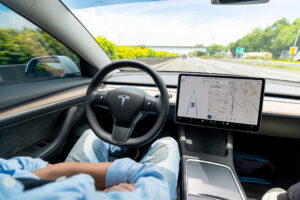
Tesla, Ram and Subaru vehicles have highest crash rate, LendingTree study says
By Teresa Moss onBusiness Practices | Collision Repair | Technology
Tesla vehicles were found to have the highest crash rate out of 30 brands reviewed in a recent LendingTree study.
The study was released just days after Tesla recalled more than 2 million vehicles upon the conclusion of a two-year investigation into the safety of the vehicles by the National Highway Traffic Safety Administration (NHTSA).
LendingTree found Tesla vehicles were involved in 23.54 crashes per 1,000 drivers between Nov. 14, 2022 and Nov. 14, 2023. Ram vehicles followed with 22.76 crashes and Subaru with 20.90 crashes.
Vehicles with the least accidents included Pontiac with 8.41 accidents per 1,000. Followed by Mercury with 8.96 and Saturn with 9.13.
Tesla drivers also came in second for driving incidents, which included LendingTree analyzing accidents, DUIs, speeding, and citations. The brand’s drivers had 31.13 incidents per 1,000 drivers. Ram led the category with 32.90 incidents and Subaru followed with 30.09 incidents.
Researchers analyzed tens of millions of QuoteWizard by LendingTree insurance quotes for the study, its website said. QuoteWizard is an insurance comparison platform, according to its website.
Citations reviewed included:
-
- Carelessness or recklessness
- Improper lane usage, improper passing, and improper turning
- No insurance or no license to operate a vehicle or misrepresenting a license
- Failure to yield to a car or pedestrian
- Safety violations, following another vehicle closely and passing a bus
- Not signaling
- Hit-and-runs involving a bicycle or pedestrian
- Having defective equipment or using the wrong road
- Comprehensive or other citations
Ram was found to have the highest incident rates in 23 states, with Tesla following in 11 states. Ram and Tesla were the only brands in the double digits, the analysis said.
To review a list of the top brands per state click here.
Tesla recalled multiple models using its advanced driver assistance system (ADAS) “Autopilot” and “Autosteer” technology on Dec. 5 after being instructed to do so by NHTSA.
Tesla’s autopilot is a suite of driver assistance features that includes traffic-aware cruise control, according to the company. The autosteer beta feature detects lane markings, road edges and the presence of vehicles and objects.
“In certain circumstances when Autosteer is engaged, and the driver does not maintain responsibility for vehicle operation and is unprepared to intervene as necessary or fails to recognize when Autosteer is canceled or not engaged, there may be an increased risk of a crash,” the recall report states.
A separate recall issued by Tesla earlier this year involved all vehicles equipped with Full Self-Driving (FSD).
There have also been lawsuits filed over the technology, one of which Tesla won in court last month. A jury determined Autopilot wasn’t responsible for the crash at issue that killed one person and injured two others.
NHTSA said its Standing General Order that mandates reporting of certain types of crashes involving automated driving system (ADS) or SAE ADAS Level 2-equipped vehicles “has already provided a wealth of additional information for investigators” and Tesla’s Dec. 5 recall is “the result of NHTSA’s thorough investigative work.”
“Specifically, the investigation found that Tesla’s unique design of its Autopilot system can provide inadequate driver engagement and usage controls that can lead to foreseeable misuse of the system,” an NHTSA spokesperson previously told Repairer Driven News. “In its Defect Information Report, Tesla stated that Autopilot’s software system controls ‘may not be sufficient to prevent driver misuse.’
The SGO was first issued in June 2021 and updated in April 2023. OEMs must report ADS vehicle crashes if the system is used within 30 seconds of a crash and involves property damage or injury. The same reporting timeframe is required for Level 2 ADAS vehicles, but the crash must also involve a vulnerable road user (such as a pedestrian, motorcyclist, or bicyclist), or result in a fatality, vehicle tow-away, an air bag deployment, or anyone being taken to a hospital for medical treatment.
Images
Photo courtesy of PonyWang/iStock
